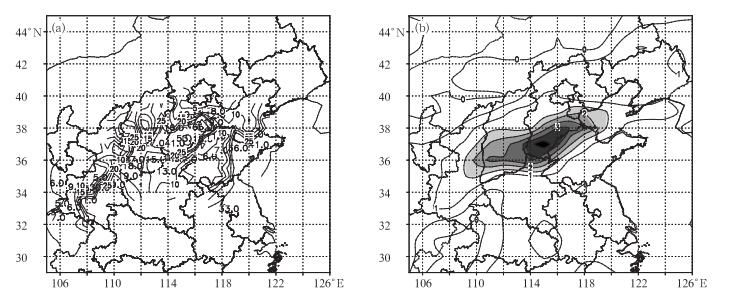非均匀饱和广义湿位涡在暴雨分析与预测中的应用
Application of Generalized Moist Potential Vorticity in Non-uniformly Saturated Atmosphere to Torrential Rain Forecast
-
摘要: 考虑实际大气非均匀饱和特性, 通过引入广义位温及广义湿位涡方程, 对华北暴雨和江淮梅雨锋暴雨的发生及落区进行了广义湿位涡异常的诊断分析, 表明暴雨形成时大气低层有广义湿位涡的异常出现。对广义湿位涡倾向的计算表明:它对暴雨的发生有一定指示作用, 因而可利用广义湿位涡的异常来识别暴雨的出现。Abstract: The introduction of generalized potential temperature and tendency equation of generalized moist potential vorticity into the thermodynamic framework is based on the non-uniform saturation of real atmosphere. The generalized moist potential vorticity (GMPV) equation is deduced by absorbing the generalized potential temperature. The water vapor and its gradient effect can be manifested in the GMPV equation, which indicates the convergence mechanism of water vapor at lower levels when torrential rain occurs. The GMPV anomaly is used in diagnostic studies of torrential rain both in North China and Yangtze River Basin. The results show that dynamic identification and forecasting of torrential rain from the perspective of generalized moist potential vorticity and its anomaly are effective, which maybe provide a new thought for the operational application of the GMPV.
-
图 1 2001年7月27日06:00地面6 h降水实况 (单位:mm)(a) 与850 hPa广义湿位涡 (单位:PVU; 阴影区是广义湿位涡值≥1.5 PVU的区域, 1 PVU=10 -6K·m3·kg -1·s -1)(b)
Fig. 1 Horizontal distribution of 6-hour precipitation from observation (unit:mm)(a), generalized moist potential vorticity at 850 hPa (unit:PVU; the shade area represents the generalized moist potential vorticity value≥1.5 PVU)(b) at 06:00 on July 27, 2001
图 2 2003年7月9日00:00地面6 h降水实况 (单位:mm)(a) 与925 hPa广义湿位涡 (单位:PVU; 阴影区是广义湿位涡值≥1.5 PVU的区域)(b)
Fig. 2 Horizontal distribution of 6-hour precipitation from observation (unit:mm)(a), generalized moist potential vorticity at 925 hPa (unit:PVU, the shade area represents the generalized moist potential vorticity value≥1.5 PVU)(b) at 00:00 on July 9, 2003
图 4 暴雨中心点不同高度处广义湿位涡倾向的时间演变 (单位:10 -8 PVU·s -1)(a)37°N, 115°E处2001年7月26日06:00—27日18:00, (b)33°N, 119°E处2003年7月7日18:00—9日06:00
Fig. 4 The generalized moist potential vorticity tendency evolution of the torrential rain center at 37°N, 115°E from 06:00 on July 26 to 18:00 on July 27, 2001 (a) and at 33°N, 119°E from 18:00 on July 7 to 06:00 on July 9, 2003 (b)(unit:PVU·s -1)
-
[1] Ertel H. Ein neuer hydrodynamischer Erhaltungssatz. Naturwissenschaften, 1942, 30:543-544. doi: 10.1007/BF01475602 [2] Robison W A. On the structure of potential vorticity in baroclinic instability. Tellus, 1989, 41A:275-284. doi: 10.1111/tela.1989.41A.issue-4 [3] Betts D A, Hoskins B J. Conditional symmetric instability—a possible explanation for frontal rainbands. Quart J Roy Meteor Soc, 1979, 105:945-962. doi: 10.1002/(ISSN)1477-870X [4] Betts D A, Sharp J C. The relevance of conditional symmetric instability to the prediction of mesoscale frontal rainbands. Quart J Roy Meteor Soc, 1982, 102:595-602. doi: 10.1002/qj.49710845707/full [5] Hoskins B J, Berrisford P. A potential vorticity perspective of the storm of 15—16 October 1987. Weather, 1988, 43:122-129. doi: 10.1002/wea.1988.43.issue-3 [6] Davis C A, Emanuel K A. Potential vorticity diagnostics of cyclogensis. Mon Wea Rev, 1991, 119:1929-1953. doi: 10.1175/1520-0493(1991)119<1929:PVDOC>2.0.CO;2 [7] Thorpe A J. Diagnosis of balanced vortex structure using potential vorticity. J Atmos Sci, 1985, 42:397-406. doi: 10.1175/1520-0469(1985)042<0397:DOBVSU>2.0.CO;2 [8] Montgomery M T, Farrell B F. Tropical cyclone formation. J Atmos Sci, 1993, 50:285-310. doi: 10.1175/1520-0469(1993)050<0285:TCF>2.0.CO;2 [9] Hertenstein R F A, Schubert W H. Potential vorticity anomalies associated with squall lines. Mon Wea Rev, 1991, 119:1663-1672. doi: 10.1175/1520-0493(1991)119<1663:PVAAWS>2.0.CO;2 [10] Shapiro M A. A multiple structured frontal zone-jet stream system as revealed by meteorologically instrumented aircraft. Mon Wea Rev, 1974, 102:244-253. doi: 10.1175/1520-0493(1974)102<0244:AMSFZJ>2.0.CO;2 [11] Shapiro M A. The role of turbulent heat flux in the generation of potential vorticity in the vicinity of upper-level jet stream systems. Mon Wea Rev, 1976, 104:892-906. doi: 10.1175/1520-0493(1976)104<0892:TROTHF>2.0.CO;2 [12] Montgomery M T, Farrell B F. Moist surface frontogenesis associated with interior potential vorticity anomalies in a semigeostrophic model. J Atmos Sci, 1991, 48:343-347. doi: 10.1175/1520-0469(1991)048<0343:MSFAWI>2.0.CO;2 [13] Chan D S T, Cho H R. Meso-scale potential vorticity anomalies and rainbands.Part Ⅰ:Adiabatic dynamics of potential vorticity anomalies. J Atmos Sci, 1989, 46:1713-1723. doi: 10.1175/1520-0469(1989)046<1713:MPVAAR>2.0.CO;2 [14] Xu Q. Formation and evolution of frontal rainbands and geostrophic potential vorticity anomalies. J Atmos Sci, 1992, 49:629-648. doi: 10.1175/1520-0469(1992)049<0629:FAEOFR>2.0.CO;2 [15] 高守亭, 雷霆, 周玉淑.强暴雨系统中湿位涡异常的诊断分析.应用气象学报, 2002, 13(6):663-670. http://qikan.camscma.cn/jams/ch/reader/view_abstract.aspx?file_no=20020687&flag=1 [16] Gao S, Pin F, Li X. A convective vorticity vector associated with tropical convection:A two-dimensional cloud-resolving modeling study. J Geophys Res, 2004, 109:D14106. doi: 10.1029/2004JD004807 [17] Gao S T, Li X, Tao W-K, et al. Convective and moist vorticity vectors associated with tropical oceanic convection:A three-dimensional cloud-resolving model simulation. J Geophys Res, 2007, 112:D01105. doi: 10.1029/2006JD007179/full [18] Gao S, Cui X, Zhou Y, et al. A modeling study of moist and dynamic vorticity vectors associated with two-dimensional tropical convection. J Geophys Res, 1005, 110, D17104, doi:10. 1029/ 2004JD005675. [19] Gao S, Zhou Y, Li X. Effects of diurnal variations on tropical equilibrium states:A two-dimensional cloud-resolving modeling study. J Atmos Sci, 2007, 64(2):656-664. doi: 10.1175/JAS3835.1 [20] Gao S, Wang X, Zhou Y. Generation of generalized moist potential vorticity in a frictionless and moist adiabatic flow. Geophy Res Lett, 2004, 31:L12113. https://www.researchgate.net/publication/260072745_Generation_of_generalized_moist_potential_vorticity_in_a_frictionless_and_moist_adiabatic_flow [21] Gao S, Zhou Y, Lei T, et al. Analyses of hot and humid weather in Beijing city in summer and its dynamical identification. Sci in China (Series D:Earth Sciences), 2005, 48(Supp Ⅱ): 128-137. http://mall.cnki.net/magazine/Article/JDXG2005S2010.htm [22] Yang S, Gao S, Wang D. Diagnostic analysis of the ageostrophic Q vector in the non-uniformly saturated, frictionless and moist adiabatic flow. J Geophys Res, 112, No.D9, D09115 10.1029/2006JD007764. [23] 吴国雄, 蔡雅萍, 唐晓菁.湿位涡和倾斜涡度发展.气象学报, 1995, 53(4):387-405. http://www.cnki.com.cn/Article/CJFDTOTAL-QXXB504.001.htm [24] 李柏, 周玉淑, 张沛源.新一代天气雷达资料在2003年淮河流域暴雨模拟中的初步应用:模拟降水和风场的对比.大气科学, 2007, 31(5):683-692. http://www.cnki.com.cn/Article/CJFDTOTAL-DQXK200705006.htm [25] 倪允琪, 周秀骥, 张人禾, 等.我国南方暴雨的试验与研究.应用气象学报, 2006, 17(6):690-704. http://qikan.camscma.cn/jams/ch/reader/view_abstract.aspx?file_no=200606118&flag=1 -


 设为首页
设为首页 加入收藏
加入收藏



 下载:
下载:



